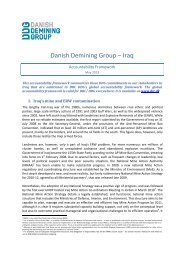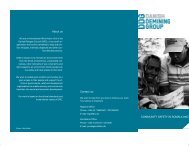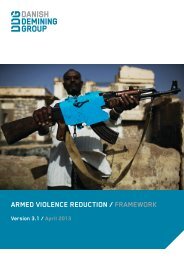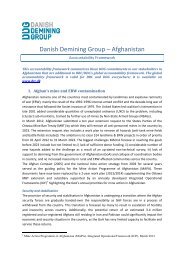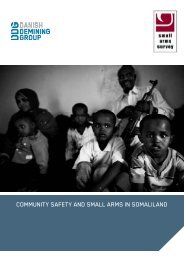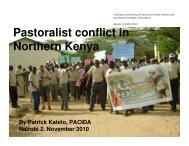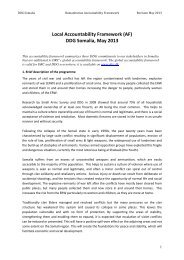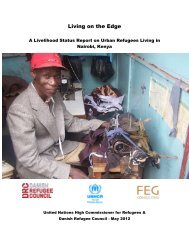Read the full report - Danish Refugee Council
Read the full report - Danish Refugee Council
Read the full report - Danish Refugee Council
You also want an ePaper? Increase the reach of your titles
YUMPU automatically turns print PDFs into web optimized ePapers that Google loves.
54 DRC / DANISH REFUGEE COUNCILCONCLUSION: What strategic role for DRC in <strong>the</strong> KIS?Can cash-based approaches work in <strong>the</strong> Kabul Informal Settlements? The answer is, undoubtedly,yes. Thanks to <strong>the</strong>ir urban location, subsequent access to functional markets, and relatively goodsecurity conditions, cash-assistance does not present higher risks than o<strong>the</strong>r forms of assistance in<strong>the</strong> KIS. However, to be efficient and not engage recipients in fur<strong>the</strong>r dependency towards assistance,findings from this research showed DRC can engage into two different types of framework,enhancing <strong>the</strong> outcomes of its existing activities:One directed at relief assistance during <strong>the</strong> winter, which is also <strong>the</strong> time when in-kindassistance is <strong>the</strong> most concentrated – with cash working as an alternative source ofincome for beneficiaries allowing <strong>the</strong>m to address immediate needs – food, but alsohealth) and address <strong>the</strong> crucial problem of indebtedness. Cash can <strong>the</strong>n be consideredas a complement to in-kind, as supply capacities of traders are lower at this period of <strong>the</strong>year, and needs are more acute.The second considering a longer-term approach, building on DRC’s exiting methods ofintervention while going fur<strong>the</strong>r by assisting transition out of training programmes through<strong>the</strong> provision of grants, and allowing household to plan for <strong>the</strong>ir expenses. Targetingwomen in households can prove as an efficient way to diversify household resources bybuilding on <strong>the</strong>ir capacity to use <strong>the</strong>ir skill to generate income.Such an ambitious dual strategy implies taking into account specific camp situations, engaging withcommunities and making sure that both <strong>the</strong> DRC staff and <strong>the</strong> targeted communities <strong>the</strong>mselvesclosely monitor all steps of implementation. Today and tomorrow, <strong>the</strong> volatile nature of security and<strong>the</strong> uncertainties of <strong>the</strong> economic environment combined with high political and media sensitivitysurrounding intervention in <strong>the</strong> KIS. It clearly calls for additional caution: assistance needs to beeffective, objectives clear and transparent to limit possible tensions.Our research fur<strong>the</strong>r showed <strong>the</strong> close interconnection of vulnerability indicators of KIS inhabitantsacross several sectors, with <strong>the</strong> problem of health for instance, being highly correlated to that ofindebtedness, housing and food consumption. Engaging in close cooperation between agenciesinvolved in <strong>the</strong> KIS appears as <strong>the</strong> most efficient way to provide an adequate response to <strong>the</strong>problems faced by IDPs in <strong>the</strong> KIS. This implies going beyond simple coordination to put in place anintegrated approach with a common monitoring and evaluation system.This study was conducted during winter, a time of <strong>the</strong> year when IDPs in <strong>the</strong> KIS are exposed to <strong>the</strong>highest risks due to (i) lack of employment opportunities with serious repercussions on <strong>the</strong> generalwell-being of household members and aggravation of <strong>the</strong> cycle of debt; (ii) lack of access to basicneeds – with a high focus on food and fuel; and (iii) higher protection concerns for children andwomen. One of <strong>the</strong> salient features of this research is <strong>the</strong> structural importance of seasonality,highlighting <strong>the</strong> importance of having specific frameworks of assistance during <strong>the</strong> winter period. Assuch, <strong>the</strong> present section will consider <strong>the</strong> potential effectiveness of cash-based assistance as:A complementary relief mechanism during <strong>the</strong> winter,A form of assistance that can effectively assist recipients in progressively escapingdistress coping mechanisms through livelihood interventions.As findings from this survey underlined health and education problems directly impactinglivelihoods in <strong>the</strong> KIS, ways of addressing those through provision of cash-basedsensitization programmes will be considered I <strong>the</strong> third section of this chapter.Lastly, given <strong>the</strong> wide range of agencies involved in providing assistance in <strong>the</strong> KIS and<strong>the</strong> high levels of vulnerabilities of IDPs in <strong>the</strong> camps, an effective approach todevelopment of Kabul informal settlements needs to take into account <strong>the</strong> possibility ofinter-agency coordination in <strong>the</strong> KIS across different sectors.



